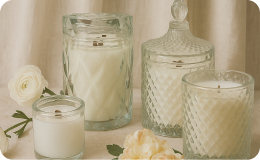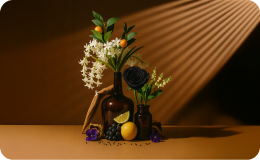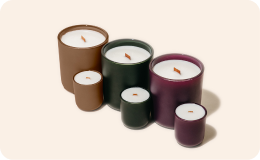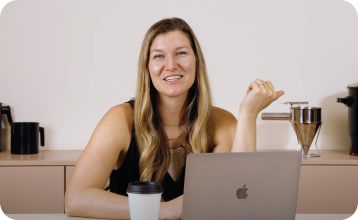Why It's Important To Burn Test Your Candles
Whether you’re new to wooden wicks or a seasoned wooden wick pro, burn testing with our wooden wick discovery kit is an important process on your path to wooden wick success. Once you have a discovery kit in hand and have gone through our wick selection guide (a quick quiz that offers suggestions based on your wax + vessel), you're ready to get started!
When creating a new candle line, burn testing is extremely important because every wick will behave just a little bit differently with varying combinations of wax types, vessel sizes, fragrance types, fragrance loads, and additives or enhancers!
The wooden wick discovery kit contains a sampling of every wick type we offer at makesy. in every size of thickness and width. Before you begin burn testing, here are some hot tips for making the most of your wick discovery kit and burn testing process.
learn about wooden wick sizes
The thickness will always be reflected in the package title. For example, Crackling Wick .02 is .02" thick - this is the least amount of width thickness. Then wick thickness goes up in .01 increments to .03" and .04".
get to know your widths
The width will be reflected on the width guide located on the outside of your package. This is a small ruler located on the package label that you can reference any time to confirm the width you are using. Flat Wick varieties come in the following size widths, smallest to largest: .375, .5, .625, and .750.
choose your wood wick type
There are 3 wick varieties to choose from, with 2 types of wicks available in color! Each wick has its own unique performance and aesthetic properties:
- Crackling: Flat wick, dark wood and color. Makes a soft, crackling ambiance.
- Whisper: Flat wick, light wood color. Makes minimal crackle.
- Shaped: Tube, spiral, or X shaped. Dark wood and color. Makes a soft, crackling ambiance. X wicks offer a pyramid-shaped flame.
There are 2 additional flat wick styles to choose from for both crackling and whisper varieties:
- Single ply: One piece of wood in .02", .03", or .04" thickness. Best for easy to burn wax blends such as Paraffin or Coco Apricot Creme.
- Booster: One larger piece of wood with an additional smaller piece adhered to the center in either .02", .03", or .04" thickness. Best for most wax blends including Virgin Coconut Soy, Beeswax Coco Creme, and 100% Soy.
- Ultimate: One larger piece of wood with an engraved booster down the center in either .02", .03", or .04" thickness. Best for most wax blends including virgin coconut soy, beeswax coco creme, and 100% Soy.
use our wick selection guide
Once you've familiarized yourself with your kit and gotten to know the different wick types, it's time to reference the wick selection guide for starting suggestions for your specific wax type and vessel size.
When working with wooden wicks, it's important to remember that a wick suggestion does not guarantee success with any given wooden wick. These are starting points to get you going so you can adjust accordingly as you see fit. After all, trial and error is a huge part of the making process!
how to burn test properly
To burn test properly and make the most of your samples, burn test every fragrance you plan to use separately and conduct a new test for any changes in additives or fragrance load. Factors such as fragrance type, fragrance load, dyes, micas, and other additives will all affect how a wick performs in any given candle recipe.
Watch this video to learn more about how to choose the right wooden wick.
common burn testing mistakes
Don't cheat yourself out of success with wooden wicks. A common shortcut we've seen in our candle making group and on message boards is that sometimes people will try to rip wicks out of the candle they're burn testing and stick a new size in if a wick is not performing.
We don't recommend this practice as it fails to replicate the exact product in the way you will ultimately produce it for your consumer, which can lead to error, skewed test results, or a failed product.
Remember, this is just as much a science as it is an art! Just as you would test for one variable at a time and replicate your control in the scientific method, you do the same in candle making. This is your lab!
Don't cheat yourself out of success by trying to take a shortcut in the process. Nailing the perfect formula is one of the greatest feelings as a maker!
Once you have chosen your wax type, vessel, fragrance, fragrance load, additives or enhancers and starting wick, it's time to conduct your tests!
steps to conduct a wooden wick burn test
Burn testing is a fun and rewarding process. It takes a little patience, but good things come to those who wait! Be sure to replicate your burn test the same every time to ensure optimal results.
- Create your control candle. Make sure to label it with your wick size, vessel size, wax type, fragrance, and fragrance load.
- Allow the candle to cool for at least 72 hours before handling, trimming, or burning to ensure its cured properly.
- Trim wick to 0.2” (5mm) above wax prior to lighting. Discard wick debris.
- Burn candle at least 2 hours or until wax melts to the edges of the vessel.
- Do not burn longer than 4 hours at a time. Do not move candle when hot.
- Always trim wick to where the wood naturally breaks off before relighting.
what to look for during your candle burn test
- You have found your optimal wick when you have a full melt in 2-3 hours, have approximately ½” melt pool, and approximately ½” flame.
- If your candle does not make a full melt in 2-3 hours, burn test with the next size up in width. Width influences the melt pool, thickness influences the candle's overall flame.
- If your candle is producing a low flame or going out, you’ll want to try the next size up in thickness first. If the flame is too big with the next thickness, then try the previous thickness with the next size up in width.
- If your flame is smoking or sooting or the flame is very high and seems out of control, this is a sign your candle is burning too hot. First, conduct a burn test with the next size down in width. If the flame is still too high, try the next size down in thickness.
Still having trouble? Watch this video and learn how to know If you have the right size wick.
next steps in your candle making
Well, you did it! You've conducted your first burn test with your wick discovery kit. If you didn't nail the perfect wick the first time or even the third time, don't get discouraged!
Trial and error is expected and is all part of the magical making process. This is about finding the optimized wick for your specific candle recipe and it's important to take it step by step and keep adjusting as necessary.
Check out our tutorial video series and FAQ for more candle making tips and tricks when working with wooden wicks. Want to get real time feedback and inspo from like-minded makers? Get connected with our Facebook group.
Don’t forget to share your creations and tag @makesy on Facebook or Instagram for the chance to be featured!
Happy testing & happy making!









